Investing in India's Consumption Growth Story

India a consumption driven economy
Domestic consumption is one of the most important divers of India’s Gross Domestic Product (GDP). India’s final consumption expenditure is 71% of India’s GDP (source: World Bank, 2022). Since liberalization India’s consumption expenditure has grown rapidly along with the growth in our GDP (see the chart below). In CY 2022, India’s total consumption expenditure stood at $ 2.4 Trillion. 80% of India’s total consumption expenditure is attributed to private consumption expenditure. As per the Economy Survey released before this year’s Union Budget, India’s private consumption expenditure at current prices in FY 2022-23 was Rs 163 lakh crores (Source: Economic Survey, Ministry of Finance, Government of India).
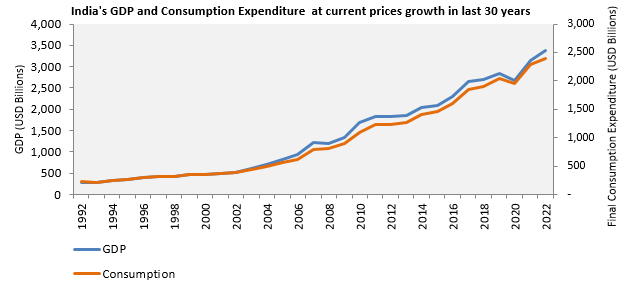
Source: World Bank (1992 – 2022). Disclaimer: The chart above is for investor education purpose only and should not be used for any other purpose.
Private consumption expenditure growth in India
Over the past 30 years post liberalization India’s private consumption expenditure (PCE) compounded annual growth rate (CAGR) was around 5%. In the last 10 years, the CAGR of private consumption expenditure has increased to 5.7% (see the chart below). It is noteworthy that India has been able to maintain a high growth rate of consumption expenditure for the last 10 years despite crossing the $ 1 Trillion GDP mark more than 15 years back; there are some parallels here with Chinese economy which we will discuss later.
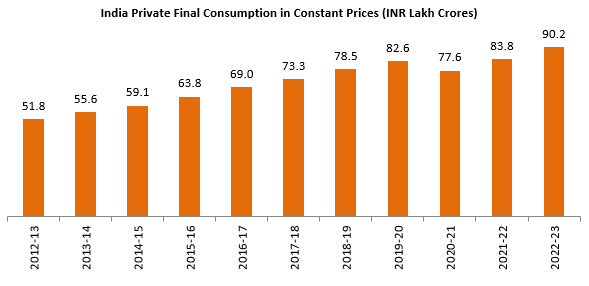
Source: Private Consumption Expenditure at Constant Prices (2011-12 series), Economic Survey (2023), Ministry of Finance, Government of India. Disclaimer: The chart above is for investor education purpose only and should not be used for any other purpose.
Drivers of consumption expenditure growth rate
One of the drivers of high PCE growth rate is the demographic dividends of our population. As per National Family Health Survey 2021, 88% of the population is below the age of 60 and more than half of the population is below 30. Rising income on a per capita basis is another driver of PCE growth rate. India’s per capita GDP at current prices crossed $2,000 in 2019 and is currently at a $2,389. Even on an inflation adjusted basis, our per capita GDP has grown at a rate of 4.5% which is quite remarkable given the size of our population. Favourable demographics and rising per capita income are the main driving factors of the growth in India’s personal consumption expenditure.
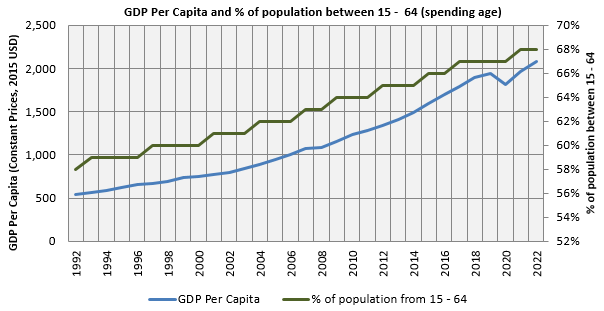
Source: World Bank (1992 – 2022). Disclaimer: The chart above is for investor education purpose only and should not be used for any other purpose.
Parallels with China – India on take-off path
China’ GDP crossed $1 Trillion in 1998. Since then China’s GDP in constant USD terms has grown at 9%. However, this growth rate has slowed down to about 6% in the last 10 years. India crossed $1 Trillion in 2007. Since then our GDP in constant USD terms has grown at 5.8%, which is in the same ballpark as China’s GDP growth rate in the last 10 years.
The difference to note here is that, while China has been largely an export driven economy, India is a largely a domestic consumption driven economy. In that regard, it will be more useful to look at per capita income because per capita income drives consumption growth. China’s per capita income crossed $2,000 in 2006 (we crossed $2,000 in 2019). In the next 10 year’s its per capita income grew to $8,094 i.e. 4 times (source: World Bank, China, 2016).
Can India grow its per capita income by 4 times in the next 10 – 15 years? China is not the only economy which was able to grow it’s per capital fourfold in the next 10 years after crossing per capita income of $2,000. Evidence from other large Asian economies points to similar growth trends (see the chart below). You can see that each of these countries were able to grow their per capita income by approximately 4 times in the next 10 years following the $2,000 per capita income milestone. Based on historical precedence from these Asian markets, Indian can replicate China’s per capita income growth story in the next 10 – 15 years.

Source: World Bank (1970 – 2022). Per capita incomes are in USD. Disclaimer: The chart above is for investor education purpose only and should not be used for any other purpose.
As China grew its per capita income 4 times, it saw huge consumption growth during this period:-

Source: HSBC MF. Disclaimer: The chart above is for investor education purposes only and should not be used for any other purpose. The industry sectors mentioned above are not investment recommendations.
In some of these spend categories mentioned above India’s current PCE is at the same level as China’s in 2006. If we can replicate per capita income growth, we can see phenomenal growth in our private consumption expenditures.
How can India replicate China’s consumption story?
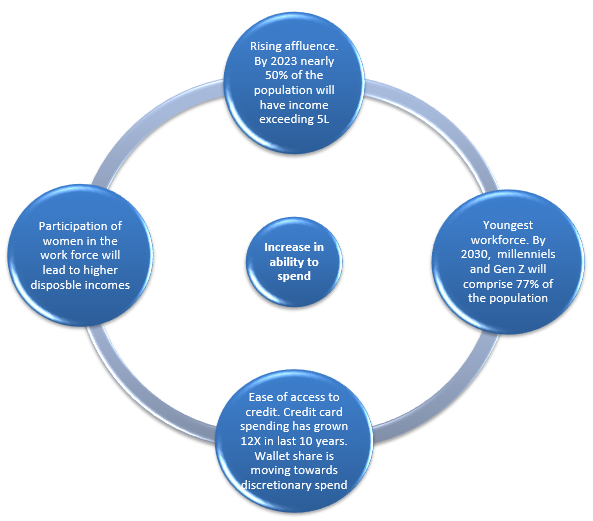
Source: HSBC MF. Disclaimer: The chart above is for investor awareness purposes only and should not be used for any other purpose.
Consumption as an investment theme has outperformed the market
The chart below shows the growth of Rs 10,000 investment in Nifty India Consumption TRI versus the Nifty 50 TRI over the last 10 years. In the last 10 years Nifty India Consumption TRI generated 14.3% CAGR returns, 50 bps higher CAGR returns than Nifty 50 TRI.
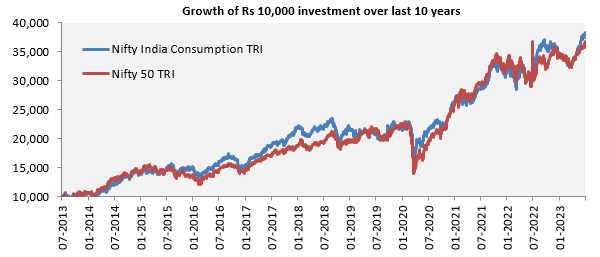
Source: National Stock Exchange, as on 30.06.2023. Disclaimer: The chart above is for investor awareness purposes only and should not be used for any other purpose. Past performance may or may not be sustained in the future.
What are the sectors in consumption theme?
Many investors think consumption is synonymous with Fast Moving Consumer Goods (FMCG). However, consumption theme is much broader and covers many sectors (see the chart below) that are integral to the India Growth Story.
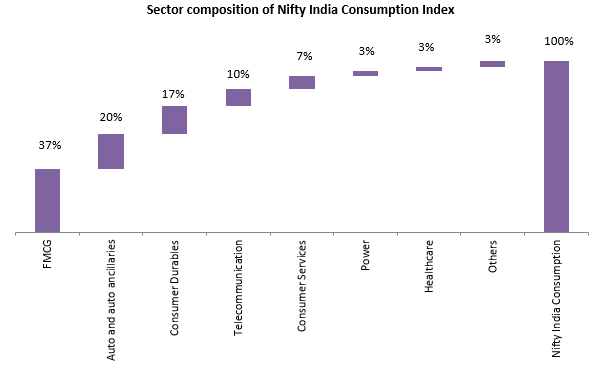
Source: National Stock Exchange, as on 30.06.2023. Disclaimer: The chart above is for investor awareness purposes only and should not be used for any other purpose.
Summary
Global investment experts believe that the next decade is India’s decade. Our domestic consumption will be central to the India growth story since our economy is largely domestic consumption driven. In this article we discussed how favourable demographics, macroeconomics and rising income/prosperity will propel to replicate the Chinese consumption growth story. Thematic consumption equity mutual funds provide you investment opportunities in India’s domestic consumption growth theme. Investors should consult with their financial advisors or mutual fund distributors if they want to know more about Thematic Consumption Funds.
An Investor Education & Awareness Initiative
Investors should deal only with Registered Mutual Funds, to be verified on SEBI website under Intermediaries/Market Infrastructure Institutions. Refer to www.assetmanagement.hsbc.co.in for details on completing a one-time KYC (Know Your Customer) process, change of details like address, phone number and change of bank details etc. For complaints redressal, either visit www.assetmanagement.hsbc.co.in or SEBI’s website www.scores.gov.in. Investors may refer to the section on ‘Investor Education’ on the website of Mutual Fund for the details on all ‘Investor Education’ on the website of Mutual Fund for the details on all ‘Investor Education and Awareness Initiatives’ undertaken by the AMC.
Disclaimer: This document has been prepared by HSBC Asset Management (India) Private Limited for information purposes only and should not be construed as i) an offer or recommendation to buy or sell securities referred to herein or any of the funds of HSBC Mutual Fund: or ii) an investment research or investment advice. Investors should seek personal and independent advice regarding the appropriateness of investing in any of the funds, securities, other investment or investment strategies that may have been discussed or referred herein and should understand that the views regarding future prospects may or may not be realized. This document is intended only for those who access it from within India and approved for distribution in Indian jurisdiction only. Distribution of this document to anyone (including investors, prospective investors or distributors) who are located outside India or foreign nationals residing in India, is strictly prohibited.
Issued as an investor education initiative by HSBC Mutual Fund.
Mutual Fund Investments are subject to market risk, read all scheme related documents carefully.
CL 482
We are a global asset manager with a strong heritage of successfully connecting our clients to global investment opportunities.
Our proven expertise in connecting the developed and developing world allows us to unlock sustainable investment opportunities for investors in all regions. Through a long-term commitment to our clients and a structured and disciplined investment approach, we deliver solutions to support their financial ambitions.
Other Links
POST A QUERY





